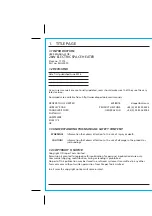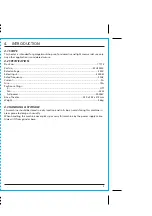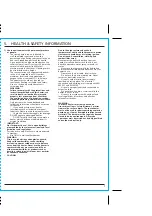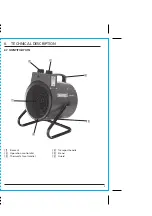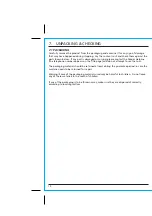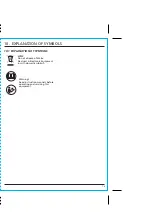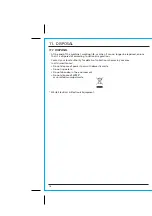
5. HEALTH & SAFETY INFORMATION
5.1 GENERAL HEATER SAFETY
WARNING
WARNING: Read all safety warnings and all
instructions.
Failure to follow the warnings and
instructions may result in electric shock, fire and/or
serious injury.
Save all warnings and instructions for future
reference.
1) Work area safety
a) Keep work area clean and well lit.
Cluttered
or dark areas invite accidents.
b) Do not operate heaters in explosive
atmospheres, such as in the presence of
flammable liquids, gases or dust.
Heaters
create sparks which may ignite the dust or
fumes.
c) Keep children and bystanders away while
operating a heater.
Distractions can cause you
to lose control.
2) Electrical safety
a) Heaters plugs must match the outlet. Never
modify the plug in any way. Do not use any
adapter plugs with earthed (grounded)
heaters.
Unmodified plugs and matching
outlets will reduce risk of electric shock.
b) Avoid body contact with earthed or grounded
surfaces such as pipes, radiators, ranges and
refrigerators.
There is an increased risk of
electric shock if your body is earthed or
grounded.
c) Do not expose heaters to rain or wet
conditions.
Water entering a heater will
increase the risk of electric shock.
d) Do not abuse the cord. Never use the cord for
carrying, pulling or unplugging the heater.
Keep cord away from heat, oil, sharp edges or
moving parts.
Damaged or entangled cords
increase the risk of electric shock.
e) When operating a heater outdoors, use an
extension cord suitable for outdoor use.
Use
of a cord suitable for outdoor use reduces the
risk of electric shock.
f) If operating a heater in a damp location is
unavoidable, use a residual current device
(RCD) protected supply.
Use of an RCD
reduces the risk of electric shock.
3) Personal safety
a) Stay alert, watch what you are doing and use
common sense when operating a heater. Do
not use a heater while you are tired or under
the influence of drugs, alcohol or medication.
A moment of inattention while operating
heaters may result in serious personal injury.
b) Use personal protective equipment. Always
wear eye protection.
Protective equipment
such as dust mask, non-skid safety shoes, hard
hat, or hearing protection used for
appropriate conditions will reduce personal
injuries.
c) Prevent unintentional starting. Ensure the
switch is in the off position before connecting
to power source.
d) Remove any adjusting key or wrench before
turning the heater on.
A wrench or a key left
attached to a rotating part of the heater may
result in personal injury.
e) Dress properly. Do not wear loose clothing or
jewellery. Keep your hair, clothing and gloves
away from moving parts.
Loose clothes,
jewellery or long hair can get sucked into the
in moving parts of the heater.
4) Heater use and care
DO NOT move the heater when it is in operation
or when plugged into the mains supply. Only
move heater once it has cooled and it has been
unplugged.
a) Use the correct heater for your application.
The correct heater will do the job better and
safer at the rate for which it was designed.
b) Do not use the heater if the switch does not
turn it on and off.
Any heater that cannot be
controlled with the switch is dangerous and
must be repaired.
c) Disconnect the plug from the power source
before making any adjustments.
Such
preventive safety measures reduce the risk of
starting the heater accidentally.
d) Store idle heater out of the reach of children
and do not allow persons unfamiliar with the
heater or these instructions to operate the
heater.
Heaters are dangerous in the hands of
untrained users.
e) Maintain heaters. Check for misalignment or
binding of moving parts, breakage of parts
and any other condition that may affect the
heaters operation. If damaged, have the
heater repaired before use.
Many accidents
are caused by poorly maintained heaters.
g) Use the heater, in accordance with these
instructions, taking into account the working
conditions and the work to be performed.
Use
of the heater for operations different from
those intended could result in a hazardous
situation.
5) Service
a) Have your heater serviced by a suitably
qualified repair person using only identical
replacement parts.
This will ensure that the
safety of the heater is maintained.
6) Use in environments with no permanent
presence of people.
-
Warning posters must be displayed
prohibiting people from being permanently in
that room.
-
The space heaters must only be used for room
drying purposes only, provided that there is a
guaranteed quantity of air exchange
necessary for combustion.
-
The necessary quantity of air will be reached
when the volume of the room (in m3) is at
least 10 times the nominal calorific power (in
kW) of all space heaters used in that room.
-
Normal air circulation through doors and
windows must be ensured.
6
Summary of Contents for ESH2000C
Page 15: ...NOTES 15 ...


